Discover 11 hidden attractions, cool sights, and unusual things to do in Decorah (United States). Don't miss out on these must-see attractions: Burr Oak House/Masters Hotel, Vesterheim Norwegian-American Museum, and Porter House Museum. Also, be sure to include Locust School in your itinerary.
Below, you can find the list of the most amazing places you should visit in Decorah (Iowa).
Table of Contents
Burr Oak House/Masters Hotel
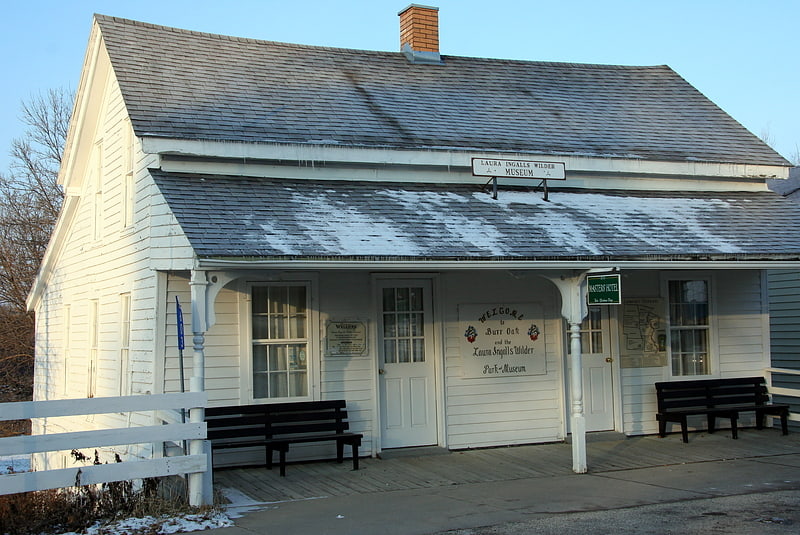
The Burr Oak House/Masters Hotel, also known as the Laura Ingalls Wilder Museum and Park, is a historic building located in Burr Oak, Iowa, United States. The 1½-story frame structure was built in 1856, and features a full width front porch and a raised basement. Its significance is derived from three elements of its history. First, it is one of the few pre-1860 buildings that was built specifically as a hotel that remains in Iowa. Second, it served as a hotel in a small Iowa town for a significant period of time, enduring changing economic times and tastes. The hotel started as a log structure that was built in 1851, and after this building was built five years later, remained in business until 1878 with different owners and names. At that time it became a dry goods and general store, and served that purpose into the early 1890s when Dr. W.H. Emmons used it as a residence and office. Around 1896 a two-story addition, no longer extant, was built onto the south side and it was made exclusively into a house.
The third significant element of the former hotel is its association with author Laura Ingalls Wilder, who lived here as a child from 1876 to 1877. It is the only known extant building occupied by the Ingalls' family in Burr Oak. Her father Charles ran the hotel, and worked in a saw mill. The family moved into the grocery store next door, before leaving town in 1878. The building was in a dilapidated state when it was bought in 1973 by Laura Ingalls Wilder Park, Inc. They restored the building and turned it into a museum. It was listed on the National Register of Historic Places in 1983.
The Burr Oak Savings Bank, across the street from the hotel, serves as the visitors' center for the museum.[1]
Address: 3603 236th Ave, Burr Oak, Decorah
Vesterheim Norwegian-American Museum
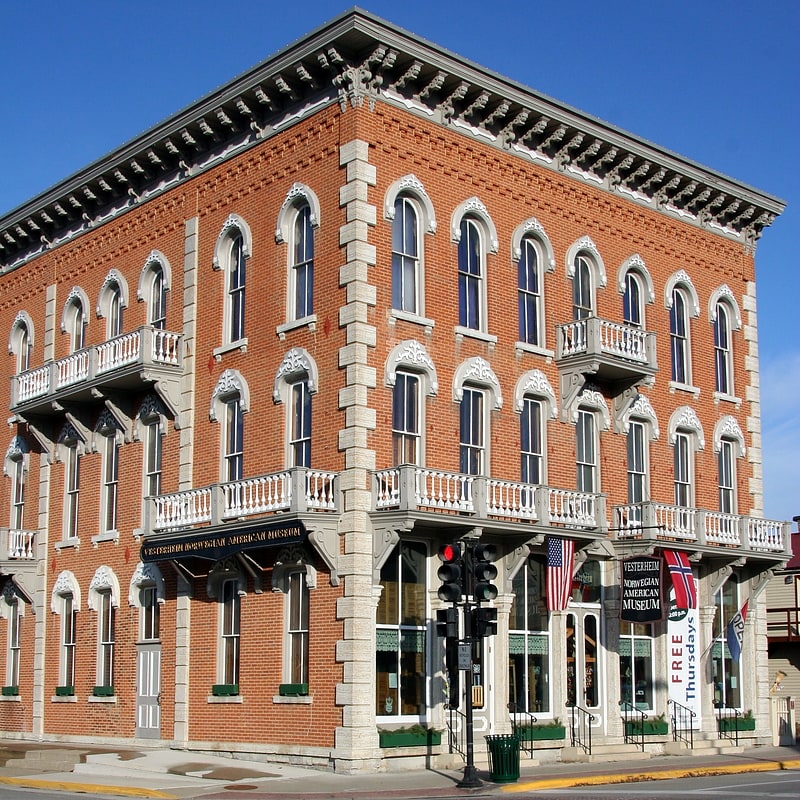
Museum in Decorah, Iowa. Vesterheim Norwegian-American Museum in Decorah, Iowa is the National Norwegian-American Museum and Folk Art School, with over 33,000 artifacts, 12 historic buildings, and a library and archives. This treasure showcases one of the most extensive collection of Norwegian- American artifacts in the world and highlights the best in historic and contemporary Norwegian folk and fine arts. Some of its buildings are on the National Register of Historic Places.
Vesterheim’s exhibitions explore the diversity of American immigration through the lens of the Norwegian-American experience, and its classes welcome students to participate in the continual evolution of traditional folk art as it meets new influences. Vesterheim also offers educational events, publications, and lectures related to its mission.[2]
Address: 520 W Water St, 52101-1734 Decorah
Porter House Museum
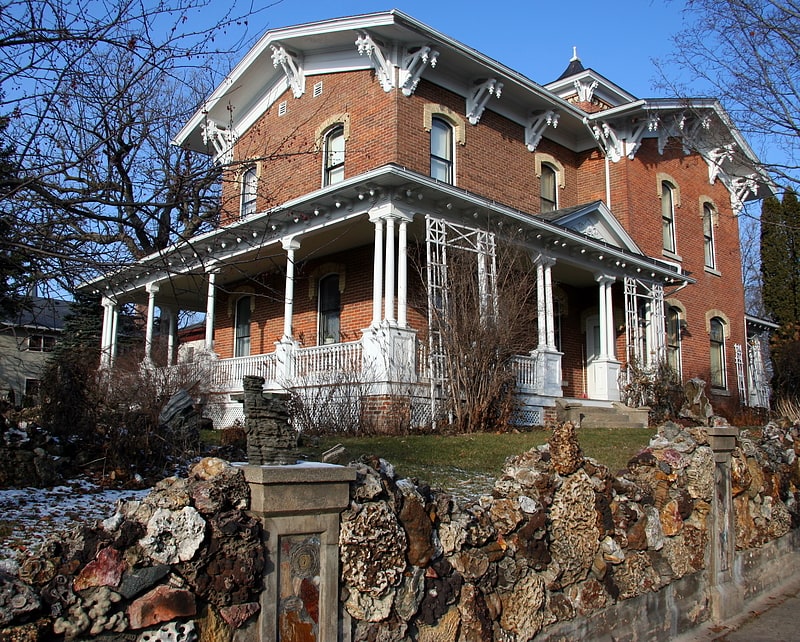
Museum in Decorah, Iowa. The Porter House Museum is a house and museum in Decorah, Iowa. It was the home of Adelbert Field Porter and his wife, Grace Young Porter, as well as Grace's mother and father, until their deaths. On August 6, 1975, the house was added to the National Register of Historic Places.
The house is built in the Italianate style and is located at 401 W. Broadway in Decorah. It is within the Broadway–Phelps Park Historic District, also listed in the National Register of Historic Places.[3]
Address: 401 W Broadway St, 52101-1741 Decorah
Locust School

Museum in the Winneshiek County, Iowa. Locust School is a historic building located north of Decorah, Iowa, United States. Built in 1854, the one-room schoolhouse is composed of rubble ashlar limestone and capped with a gable roof. The lintels and window sills are also stone. A belfry with round-arch openings is located above the main entrance. The school was established just after the village of Locust was surveyed and settlement had begun. It remained in operation with all elementary grades until 1950, when it was reduced to specific grades. It was closed in 1960. The Winneshiek County Historical Society acquired the building and operates a museum in it. It was one of the first school buildings constructed in Winneshiek County. The building was listed on the National Register of Historic Places in 1978.[4]
Address: 1640 Big Canoe Rd, 52101-7438 Decorah
Winneshiek County Courthouse
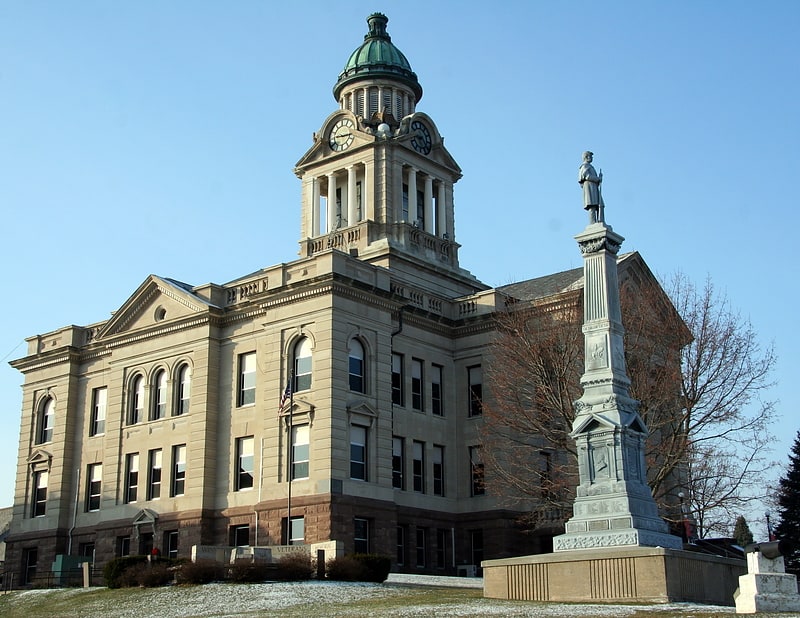
The Winneshiek County Courthouse is located in Decorah, Iowa, United States. It is the second building used for court functions in Winneshiek County. The courthouse was included as a contributing property in the Broadway-Phelps Park Historic District in 1976.[5]
Address: 204 West Broadway Street, Decorah
Steyer Opera House

Building in Decorah, Iowa. Steyer Opera House is a historic building located in Decorah, Iowa, United States. The three-story, brick commercial block was designed by F.G. Brant of Dubuque. Its original owner and namesake was Joseph Steyer, who emigrated from Luxembourg in 1852 and settled in Decorah in 1865. The building was built in 1870 and an additional three bays were added to the east side in 1875. The first floor houses retail space, the second floor historically housed apartments, and the auditorium is on the third floor. The walls and ceiling are covered with tin that is pressed in a variety of decorative patterns. Doorways flank the proscenium. They are framed by paneled pilasters and capped with a broad architrave. The balcony that rings the main floor on three sides of the auditorium was part of the 1875 renovation of the building. It is now part of the neighboring Hotel Winneshiek. The building was individually listed on the National Register of Historic Places in 1980. In 2017 it was included as a contributing property in the Decorah Commercial Historic District.[6]
Decorah Ice Cave State Preserve
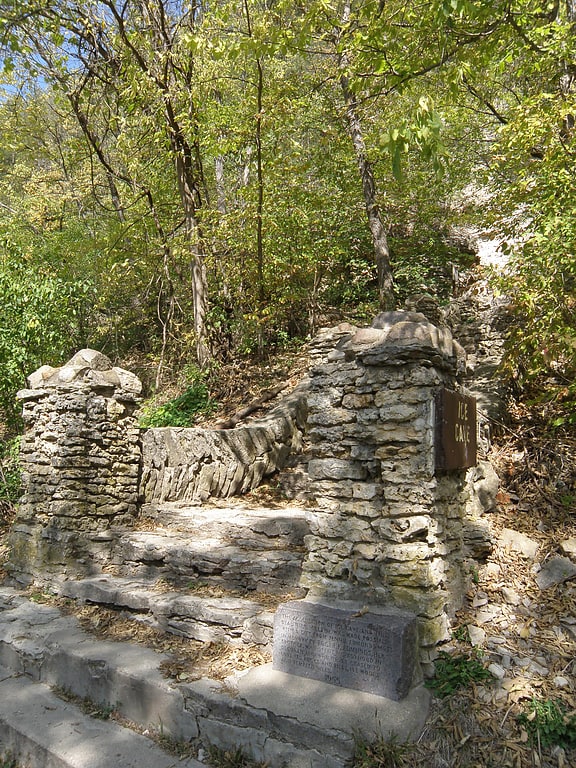
Park in the Winneshiek County, Iowa. Decorah Ice Cave State Preserve has one of the largest ice caves in the Midwestern United States. It consists of a 3-acre parcel of land at the edge of Barbara Barnhart VanPeenen Memorial Park in the northern portion of the city of Decorah, in Winnesheik County, Iowa.
Ice Cave is open to the public as an 'enter at your own risk' attraction. In the late 1990s, the Department of Natural Resources Geological Survey Bureau required a permanent barrier be installed due to some rock movement. Since then, a large rock has fallen and visitors are now only able to comfortably walk into the cave about 10 feet from the entrance.
Ice caves are one characteristic of karst topography, along with sinkholes and cave systems, all of which are present in the area, a portion of the Driftless Area of Iowa. From autumn and into early winter the cave is dry. Ice begins to form in January or February near the entrance and continues down to the lower levels. Several inches of ice on the north wall materializes by late May, and generally remains until late August.
The cave was given to Decorah in 1954 and remains the property of the city. It was declared a state geological state preserve in 1973. It was placed on the National Register of Historic Places in 1978.[7]
Norris Miller House
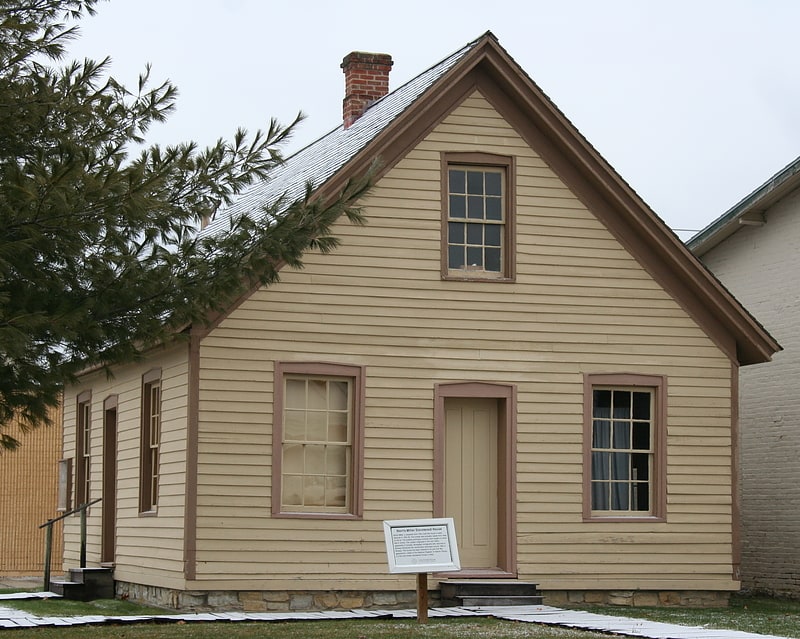
The Norris Miller House, also known as The Stovewood House, is a historic residence located in Decorah, Iowa, United States. The 1½-story frame house features a vernacular Classical cornice, symmetrical plan, a gable roof, and a limestone basement. The structure is composed of oak that is split into short lengths for use in a stove, or stovewood. It is laid with mortar made up of ash and lime. There are only two other houses like this one known to exist in the United States, and both are in Wisconsin.
Decorah had two other houses similar to this one, but they have been torn down. All them could have been built by Norris Miller, who settled in Decorah from Ohio in 1855. That year he bought a town lot, and completed this house in 1856. The house was moved to the Vesterheim Norwegian-American Museum in 1976 in order to preserve it. They restored the house and made part of it exhibit. It was listed on the National Register of Historic Places the same year it was moved.[8]
Painter-Bernatz Mill
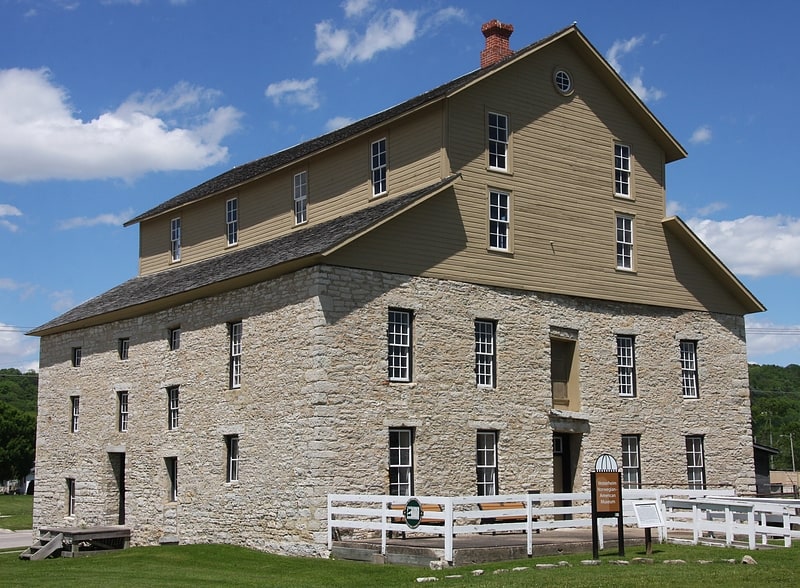
Museum. Painter-Bernatz Mill, also known as the Old Stone Mill, is a historic building located in Decorah, Iowa, United States. The original part of the mill was constructed by William Painter in 1851, and it was expanded to its present size in the next year or two. A mill race was constructed from a dam on the Upper Iowa River, and it was routed beneath the building to power the turbine. It was the first of at least 15 mills that used this river as its source of power. The lower two floors are composed of native limestone. The original hip roof was removed sometime between 1874 and 1890 and the present gable roof was built giving the mill a large loft. Diesel power replaced water power in 1947. The building continued to operate as a mill until 1964. It became a part of the Vesterheim Norwegian-American Museum in 1971, and houses exhibits on agriculture and industry. It is also a site in the Silos & Smokestacks National Heritage Area. The former mill is the oldest building in Decorah. It was listed on the National Register of Historic Places in 1974.[9]
Decorah Commercial Historic District

The Decorah Commercial Historic District is a nationally recognized historic district located in Decorah, Iowa, United States. It was listed on the National Register of Historic Places in 2017. At the time of its nomination it contained 126 resources, which included 85 contributing buildings, one contributing structure, and 40 non-contributing buildings. The historic district covers most of the city's central business district. Water Street, which is a major thoroughfare through the district was named after a millrace that rerouted water from the Upper Iowa River to serve the needs of the mills and the commercial district. The land here is relatively flat and allowed for a linear shopping area. The Broadway–Phelps Park Historic District is largely a residential area that is located to the south.
The buildings in the district are primarily two to three stories tall and built with brick. There are, however, some stone and wood buildings. A majority of the buildings (60%) were built before 1899, with the oldest building from 1853. Another 27% were built between 1900 and 1960. As of 2017, the newest building was from 2014. The buildings are generally vernacular in style, but reflect the styles that were fashionable from the time they were built, including Italianate, Queen Anne, Romanesque, and Colonial Revival. Some of the buildings were designed by architects and built by local contractors, but the designers of most of the buildings are unknown. Architects of note include: Charles Altfillisch, Orff and Guilbert, Turnock & Ohrenstein, Mortimer Cleveland, Gatterdamn & Probst, and Robert Jamieson. General contractor A.R. Coffeen Co. was responsible for both new construction and remodeling old facades. The Decorah Woolen Mill (1867, 1920), the only mill left in the district, and the Steyer Opera House (1870, 1875) are individually listed on the National Register of Historic Places. The brick pavers on Court Street count as the contributing structure.[10]
Decorah Woolen Mill
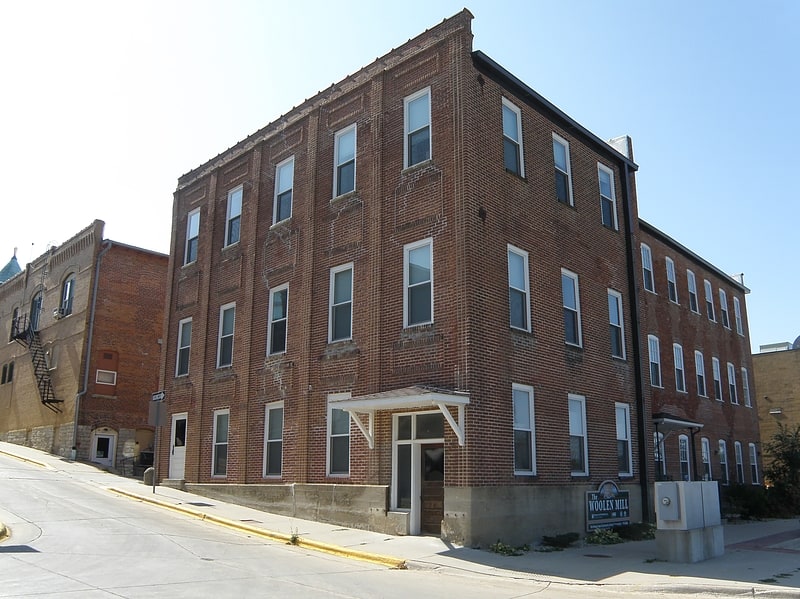
Historical landmark in Decorah, Iowa. Decorah Woolen Mill, also known as the Meritol Building or Decorah Tire Service, is a historic building located in Decorah, Iowa, United States. The mill was originally constructed in 1867, and was operated by various owners in the years to come. They included the Decorah Glove and Mitten Works who operated in the building the same year, 1908, that it was struct by a tornado. The third floor sustained damage, and they continued operations here. By 1919 they were no longer in business here and the American Drug and Press Association, the Meritol Company, bought the building and expanded it. They made pharmaceuticals and patent medicines, and went bankrupt in 1932. Various other companies operated from here until 1955 when Decorah Tire Service took over. The building was individually listed on the National Register of Historic Places in 2001. The property was developed into a 15-unit apartment building, which opened in 2002. In 2017 it was included as a contributing property in the Decorah Commercial Historic District.
The significance of this building is derived from its association with water-powered manufacturing in Decorah, and wool milling in Iowa and the Midwest in the 19th century. The Upper Iowa River, the source of its water power, flowed by the building until 1949 when the United States Army Corps of Engineers diverted it to the north as a flood prevention measure.[11]